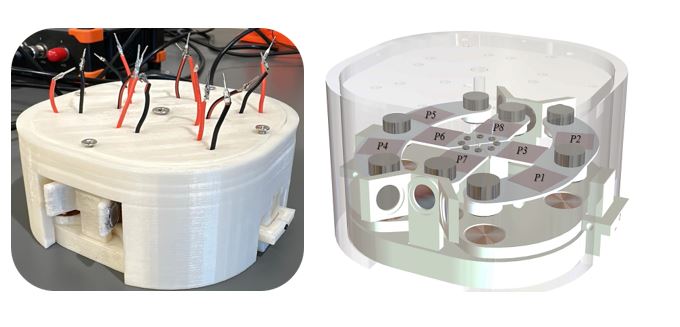About:
Hybrid Piezoelectric-Electromagnetic Energy Harvester Using a Nonlinear Curved T-Shaped Beam for Broadband Applications, this work investigates the performance of a novel hybrid piezo-electromagnetic energy harvester integrated with curved T-shaped and straight beams for efficient broadband vibration energy harvesting (VEH). The proposed system leverages the synergy between piezoelectric and electromagnetic transduction mechanisms while utilizing the unique dynamic properties of curved beams and magnetic nonlinearity to enhance energy harvesting efficiency across a wide frequency range. The developed hybrid harvester consists of two curved T-shaped beams with three piezoelectric patches and two straight cantilevers with one patch on each, with a magnet as a variable tip mass. Simulations were conducted to analyze stress distribution, modal behavior, and harmonic response under various vibrational conditions for T-shaped and curved T-shaped beams. The prototype was tested using a shaker and DAQ device for four different configurations of tip magnets with increasing mass and electromagnetic field density. The average voltage of 27.81 V for piezoelectric with an average output power of 0.773 mW as well as an energy density of 0.0101 Wm⁻³, and 0.014 V with an average power output of 0.736 nW from the electromagnetic energy harvester at 1MΩ external load for the tip mass configuration M4 within the frequency range of 1-150 Hz was achieved. In contrast, the overall average voltage generated at M1, M2, and M3 configurations is 5.38, 9.78, and 15.25 V, respectively. The frequency average voltage (FAV) was calculated for all configurations of M1, M2, M3, and M4 as 6.19, 8.25, 9.94, and 11.37 V/Hz. The findings reveal that the hybrid piezo-electromagnetic energy harvester can effectively harvest energy from broadband vibrational sources, making it a promising solution for powering wireless sensors, wearable electronics, and other low-power devices in applications such as structural health monitoring, industrial automation, and smart infrastructure.
Scientific or Technical Area:
Mechanical Engineering, Vibration energy harvesting, technology
Project Timeline:
Main Objectives of the Project:
- To propose a nonlinear coupled mathematical model of a hybrid energy harvester and, in tandem, as a metamaterial-based structure.
- To establish numerical models that can efficiently solve the nonlinear behaviour of the energy harvesting performance.
- To investigate the different design parameters that can be modified to maximize the energy harvesting properties for the application of vibration-based energy harvesting (e.g., bluff body geometry, piezoelectric material, etc.). Optimization studies can also be supplemented with either numerical or computational methods.
- To fabricate the energy harvester module and perform an experimental study in a lab-scale system that can monitor the power output in various operational scenarios
Anticipated Impact and Relevance:
A hybrid energy harvester that uses piezoelectric and electromagnetic effects can increase the voltage output compared to traditional PEH. Implementing a spatially distributed excitation method which provides an excellent platform for developing the next generation of energy harvesting systems. To realize the novel applications of hybrid metamaterial energy harvesters, the following scientific questions should be addressed through novel research:
1. Developing computational and numerical approaches to characterize piezoelectric energy harvesting metamaterials consisting of locally resonating periodic oscillators.
2. Optimally design the different parameters of PEHM given the expected vibration profiles of pipes and rails.
3. Physically demonstrating and validating a novel piezoelectric-electromagnetic metamaterial system that can power wireless sensing devices for remote applications.
Additionally, the benefit of Qatar's gas processing industry can be tremendous for powering monitoring devices in condition monitoring, leakage, and fracture detection. Process pipework in a plant is constantly subjected to vibration from various input sources (i.e., internal flow, presence of machinery .… etc.). Wireless sensing devices can provide information in inaccessible pipeline locations and provide valued data that can assist in planning maintenance activities or initiating overhaul campaigns. The project aligns with Qatar National Vision 2030, particularly its Environmental Development Pillar, through:
- Development of sustainable power sources and green energy.
- Replacing the use of lithium-ion batteries in low-powered sensors to reduce the carbon footprint.
Supervisor(s) Details:
- Full Name: Dr. Asan G. A. Muthalif
- Job Title/Position: Professor
- Department or Unit: Mechanical Engineering
- Institution/Affiliation: Qatar University
- Email Address: drasan@qu.edu.qa
Team Members Involved:
- Mohammad Farhan, PhD., Mechanical Engineering, College of Engineering
- Mohamed Sultan Mohamed Ali, Professor, Electrical Engineering, College of Engineering
Associated Resources or Publications:
- M. Farhan, Asan G.A Muthalif, MSM Ali (2024), “Innovative Approaches to Optimize Vibration Energy Harvesting (VEH): A Comprehensive Review”, Energy Reports, V12, Pg 5194-5219, https://doi.org/10.1016/j.egyr.2024.11.006
- M. Farhan, Asan G.A. Muthalif, M.AM. Sultan (2025), ‘Broadband Vibration Energy Harvesting Using Curved T-Shaped Beam Piezo-Electromagnetic Hybrid Nonlinear Harvester’, 31st International Congress on Sound and Vibration, 6-11 July 2025, South Korea (Accepted)
Picture of the Prototype:
